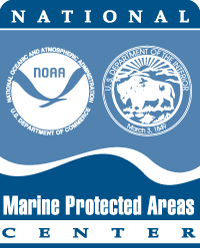Underwater Archaeology
A Resource by the Marine Protected Areas Federal Advisory Committee (These statements do not necessarily reflect the positions of NOAA or the U.S. Government)
Underwater Archaeology is the recovery of information from submerged artifacts and underwater sites for the interpretation of past human cultures.

Underwater Archaeology is the systematic documentation and recovery of information from submerged artifacts and underwater sites for the interpretation of past human cultures. Artifacts and sites, the locations of past human activity, possess information about human behavior in both the nature of the objects and in their exact distribution on or under the seafloor. Projects may be non-intrusive when no excavation or disturbance of the site is conducted, or intrusive, requiring careful excavation and selected recovery and conservation of material. Initially associated with historic shipwreck sites, it is increasingly clear that the methods and uses of underwater archaeology are equally applicable to a wide variety of resources, including aviation properties, submerged habitation sites, historic landings and anchorages, etc. Underwater archaeology also includes the interpretation of site and artifact data, in order to generate new information on past human behavior. The roots of the academic field are relatively young, beginning only in the early 1960's. Underwater Archaeology today is strongly influenced by anthropological and historical trends and reliant on associated multidisciplinary fields, such as material cultural analysis, geography/GIS, and oceanography. The majority of projects today involve diving, and these capabilities and inherent risks must be understood by the marine protected areas manager.
Opportunities and Obligations
Cultural and historic properties like underwater archaeological sites are non-renewable resources which often possess unique information about the past.

Cultural and historic properties like underwater archaeological sites are non-renewable resources which often possess unique information about the past. They often consist of public property on public bottomlands, a heritage resource owned by the people. The careful investigation of these sites can literally open a new window on voyaging and nautical technology, cultural contact and trade, marine resource use, ancient habitation, and provide insight into our past unavailable from any other source. The information held by these sites, however, is vulnerable to a host of threats, including biochemical deterioration, coastal development, and human impacts such as illegal looting or inadvertent site damage. The methods associated with Underwater Archaeology emphasize the information content of the submerged site and the careful systematic approach to data collection that most protects and preserves the resource for current and future generations. Once a site or its artifacts are damaged or haphazardly removed, there is no way to access its information and recreate the story it might have told. Resource management agencies with jurisdiction over marine and freshwater areas have a responsibility to effectively implement the existing state and federal cultural resource preservation mandates that apply to their location.
Methods and Approaches
For the assessment of maritime archaeology resources, particularly surveys which meet federal review standards, professional training and experience is a requirement.

Training in Underwater Archaeology includes field data collection, interpretation, and site preservation. The terminal degree for a job in the professional field of underwater archaeology is the Masters degree, which is currently available from only a few universities (Texas A&M, East Carolina University, University of West Florida). Various public education courses also provide knowledge of basic methods and experiential learning, emphasizing the preservation approach to artifacts and sites. Non-profit organizations (e.g. NAS, MAHS, PAST) have developed a hands-on training program specifically for sport divers. These public experiences emphasize basic non-intrusive methods. For the assessment of cultural heritage resources within a marine protected area which will meet state and federal review standards, professional experience is a requirement.
Along with training opportunities in underwater archaeology, and for any employer/employee-based diving activities, there are recognized hazards and established solutions for risk mitigation. Underwater archaeology generally falls under the definition of scientific diving, which receives certain exemptions from the Occupational Safety and Health Administration (OSHA) regulations which govern underwater work sites. Universities and agencies which manage scientific divers have established diving programs and criteria which meet or exceed standards set by the American Academy of Underwater Sciences (AAUS) or similar agencies. Diving safety officers are familiar with the requirements of institutional safe diving practices.
 Marine Protected Areas
Marine Protected Areas